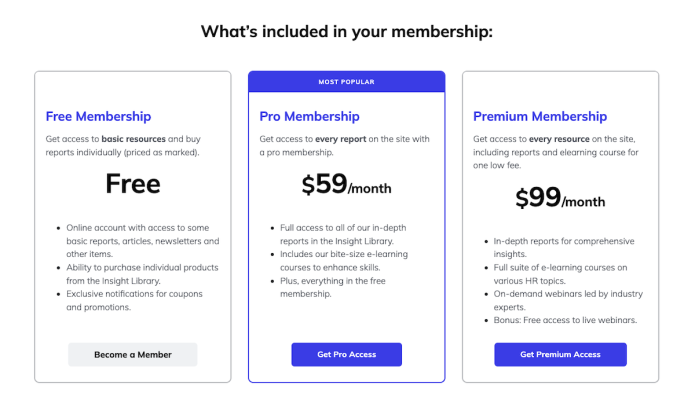
Maintaining a successful membership website requires tracking several key metrics to assess performance and make informed decisions. This is nothing new, and applies to any business. However, in a membership business, there are slightly different measurements you’ll want to track month to month that pertain specifically to membership website success.
Recurring & Non-Recurring Revenue
Revenue must be tracked in any business, but in a membership model, you will be tracking recurring revenue. You need to know how much is coming in each month and each year. You will need to take into account any discounts given, and whether you have any non-recurring subscriptions. Knowing these numbers is the first step to determining if the business you have started is viable in the long term.
Another membership-specific revenue metric that is useful is average revenue per member. This measures the average revenue generated per member within a specified period of time. Take the total revenue generated from memberships and divide by the total number of active members during the period. This number can be a benchmark that you can gauge future growth against. To increase the number, you can consider special offers and promotions to boost income in slow months.
Here are some of the most likely sources of revenue your membership site will use:
Recurring Subscription Fees
- Monthly or Annual Memberships: Charging members a recurring fee for access to premium content, exclusive resources, or specialized services offered on the website.
- Tiered Membership Levels: Offering different membership tiers with varying benefits and pricing to cater to diverse member needs.
Non-Recurring Subscription or Course
- Individual Product Sales: Selling access to specific courses, workshops, or downloadable content on a one-time purchase basis, separate from membership subscriptions.
- Course Bundles or Packages: Offering bundles of courses or content at a discounted price compared to individual purchases.
Premium Features or Add-ons
- Upselling Premium Features: Offering additional features, tools, or services beyond the standard membership as an upsell to members for an extra fee.
- Access to Experts or Exclusive Communities: Providing access to industry experts, exclusive forums, or networking opportunities for a premium price.
Events & Workshops
Host paid webinars, workshops, or conferences exclusive to members, charging admission fees for participation. As an added incentive to buy, members who are part of your higher tiered levels can receive a discount or discount with referral.
Coaching & Consulting Services
Offering one-on-one consulting, coaching, or advisory services related to the website's niche or expertise area for an additional fee. This can be done on an individual basis, or offered as a monthly or weekly group call.
E-Commerce Sales
Depending on your niche, you may want to offer branded merchandise, products, or services related to the website's niche or content. On the SubHub platform, you can easily sell physical products, digital downloads, as well as website content with the Pay Per View option.
Profit vs. Expenses
Your profit is your revenue minus expenses, and as such, is the real metric by which you can tell if your business is viable for the long term. In order to do this however, you have to know what should be considered revenue, income, cost of doing business, and what you are classifying as an expense. Business expenses for your membership website are likely to fall into these categories:
Technology & Infrastructure
These include website design, development & maintenance, membership management software, payment gateway and analytics tools.
Content Creation
If you're reasonably tech-savvy, creating your own content for your membership website won't be difficult. If not, you might need some help putting together articles, videos, webinar content, and downloadable resources for members.
Marketing & Promotion
This would include expenses for paid advertising, social media marketing, email marketing campaigns, and SEO efforts to attract and retain members.
Customer Support
You may need to factor in costs for providing customer service and support to your members to address member inquiries, technical issues, or billing queries.
Cash Flow
Cash is the actual money you have in your bank account at any given moment, as opposed to money that is coming next month through “expected” renewals. It’s important to ensure you have the cash on hand for operating expenses day to day. For example, let’s say you’ve decided to move from your current web hosting company using WordPress to an all-in-one membership website platform.
Depending on the policy of your WordPress host, and the length of your contract with them, you may need to continue making those payments for a period of time, while also paying for the new service. You would need to be sure you have the money in the bank to cover both costs for whatever (hopefully short) period of time is needed.
Member Retention & Churn Rate
Member retention and member cancelations are 2 sides of the same coin. The member retention rate indicates the percentage of members who continue their subscription or membership over a specific period. It's calculated by dividing the number of members at the end of the month by the number at the beginning and multiplying by 100. Tracking this metric helps evaluate the website's ability to retain members, identify reasons for attrition, and implement strategies to improve retention.
Churn rate represents the percentage of members who cancel or do not renew their subscriptions within a given period. It's calculated by dividing the number of members lost during the month by the total number of members at the start of the month, multiplied by 100. Monitoring the churn rate is crucial for understanding the rate of membership attrition. High churn rates may indicate dissatisfaction, lack of engagement. While it may be disappointing to discover a high churn rate, the good news is that you are able to track it, figure out why it’s there, and formulate a plan to improve it.
Member Engagement
While not directly related to income or expenses, member engagement is one of the most telling metrics you can track in your membership website. This number tells you how effective your membership model is by showing you how active your members are on your website.
Most membership software platforms provide an automatic calculation of member engagement. These may include number of member logins, number of logins per member, course enrolment, course completion, and number of files downloaded or products purchased.
If you are using a member forum, you have an additional window into your members’ perspectives on your service. Another way to gauge engagement is to offer group calls once per month for special topics or Q and A.
Keeping track of all of these metrics on a monthly and annual basis will arm you with the knowledge you need to understand exactly how your business is doing, and how to grow it in the future.
Ready to start your membership website?




